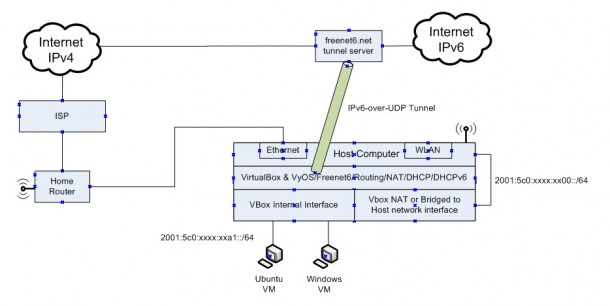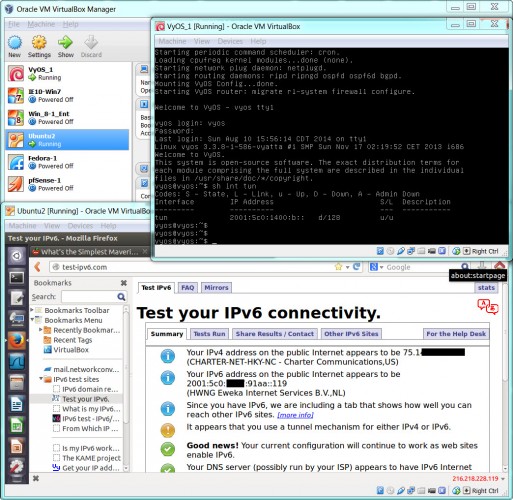
Build Your Own IPv6 Lab [Archived]
OUT OF DATE?
Here in the Vault, information is published in its final form and then not changed or updated. As a result, some content, specifically links to other pages and other references, may be out-of-date or no longer available.
Get your hands dirty. Playing with IPv6 can be the best way learn it. Jeffrey L. Carrell lays out how you can build an IPv6 lab from the comfort of your own home for no more than a few dollars.
Guest Blog Post by Jeffrey L. Carrell
IPv6 is called the new Internet protocol. However, it’s been running on the Internet since 1999, so it’s really not so new, it’s just that not a lot of networks have implemented it as of yet. The challenge is that it is different from what we are all used to working with. It’s a bigger number: 128 bits compared to IPv4’s 32 bits. It has colons instead of periods (ok, dots for us diehard networking folks). It has all new routing protocol components. And on, and on. But, it has WAY MORE possible addresses than IPv4! The theory is, we should never run out in our lifetimes! But, it is different.
So, how do you learn about IPv6 if your company is not implementing IPv6? How do you afford the equipment that is capable of running IPv6? More importantly, should you spend your own money and time to learn about IPv6 if there are no other compelling reasons or funding? The answer: YES, you should learn it on your own! A professional technologist should realize that investing in yourself is important and generally does payoff in the future. How much are you willing to invest, money wise? How about very little (and I mean ‘little’ as in a few bucks)?
For a small investment of a computer (which you probably already have), a free virtualization application, a free full-blown routing application, an Internet connection (even free WiFi at the coffee shop will work), $5.00 USD investment for an IPv6 tunnel account, and free or evaluation versions of client operating systems; you can build a sophisticated lab and learn IPv6 just as effectively as if you had invested a lot more money.
The platform I’d recommend consists of a single computer with 8+ GB ram, 200MB hard disk, dual-core or better processor, one or more networking interfaces, Oracle’s VirtualBox, VyOS (routing software), Freenet6 account and software (IPv6 tunnel service), client OS’s such as a Linux platform and/or Microsoft Windows evaluation versions, and an Internet connection that is IPv4 only. With this as a base system platform, you can also add external equipment and build a larger lab environment.
The purpose here is to “play” with IPv6. What I have found not only for myself, but for many others who I’ve had in IPv6 training classes, only reading about IPv6 does not provide adequate knowledge or the hands-on experience that leads to the actual learning of IPv6. You need to see the configuration components; you need to look at the packets with a protocol analyzer; you need to try different configuration scenarios. The doing will drive home the learning!
You can create your own IPv6 lab environment with just about any option to what I’ve outlined above. Any VM application will work, many routers and/or routing applications will work, and there are a few choices in choosing an IPv6 tunnel provider. My personal goal was to find the combination that didn’t require a lot of money or special hardware, and didn’t require specific types of Internet connectivity (e.g. you’re not required to have a static IPv4 address, generally the way home Internet services is provided). Another major aspect of this IPv6 lab system, is to have real IPv6 Internet connectivity over an IPv4 only connection, which means you can actually use IPv6 to communicate to the outside world. You can even configure a client VM to not have any IPv4 at all! I have tested this system at various WiFi hotspots, friends’ networks, and even at 37K feet in the air while flying on a plane that had WiFi.
I started with an account with Freenet6, which allowed me to build a system that provides for a /56 subnet for IPv6, which could provide up to 256 /64 IPv6 subnets. I generally design breaking the /56 into 16 /60s and then each /60 provides 16 /64s. This lets me build multiple networks, and I can then enable different IPv6 routing protocols to really test my configs. A most excellent resource specifically covering IPv6 addressing topics soon to be published is “IPv6 Address Planning” by Tom Coffeen by O’Reilly. Another great resource is Rick Graziani’s book “IPv6 Fundamentals: A Straightforward Approach to Understanding IPv6” by Cisco Press which covers not only IPv6 basics but routing in an IPv6 network as well, with a focus on Cisco IOS.
So far I’ve made it sound easy to throw all this stuff together in a pot, stir it around a bit, and presto-changeo you have a way-cool IPv6 lab. Unfortunately that is not exactly the case. It does take a bit of tweaking and modifying to make the base system work. Initially you download all the software you need and also sign up for your Freenet6 account. Then you install VirtualBox and create a VyOS virtual machine (VM). After getting the VyOS VM going, the real fun begins. You must do some updates to the Debian base which VyOS runs on and then install the freenet6 (called gogo6) client software. After getting that all going, there are a few tweaks to the gogo6 main configuration file for account info, etc., and to the router config file gogo6 calls within VyOS. It’s a bit more complicated than I have time or space to cover here. After all this, you can then configure one or more client VMs to play with.
Here is what the IPv6 Lab system could look like:

After configuring the system, I have an IPv6 tunnel up and running, and a Linux client on a different IPv6 subnet, on an IPv4 only connection to the Internet, all in VirtualBox:

If you want to learn more about how you can set up your own IPv6 home lab, I will be facilitating two half-day hands-on workshops on this project at the upcoming 2014 North American IPv6 Summit on September 23-25 in Denver Colorado. There is still time to register for the workshop and/or the IPv6 Summit.

Jeffrey L. Carrell is Network Consultant at Network Conversions. Jeff is a frequent industry speaker, freelance writer, blogger, IPv6 Forum Certified Trainer, network instructor and course developer to major networking manufacturers, and technical lead and co-author on 2 books: Guide to TCP/IP 4th Edition (contributing IPv6 content) and Fundamentals of Communications and Networking 2nd Edition. Jeff focus’s on IPv6 interoperability, and delivers lectures and IPv6 hands-on labs at technical conferences worldwide. As an IPv6 Forum Certified IPv6 Trainer, Jeff offers IPv6 Forum Silver and Gold Certified courses, customized IPv6 training courses, is an IPv6 Instructor for HP Education Services for their IPv6 Foundations course, and an IPv6 Instructor for Nephos6 for their IPv6 Foundations course. Jeff is a featured IPv6 instructor for the gogoNET online community, offering webinars and online workshops on IPv6 technologies via the gogoTRAINING initiative. Jeff is also a “Protocol Analysis Workshop” facilitator for Riverbed. Jeff has been involved in the computer industry for 35 years and has concentrated his endeavors in the internetworking portion of the industry for over 28 of those years. Jeff actively participates on IPv6 topics on twitter @JeffCarrell_v6.
Any views, positions, statements or opinions of a guest blog post are those of the author alone and do not represent those of ARIN. ARIN does not guarantee the accuracy, completeness or validity of any claims or statements, nor shall ARIN be liable for any representations, omissions or errors contained in a guest blog post.
OUT OF DATE?
Here in the Vault, information is published in its final form and then not changed or updated. As a result, some content, specifically links to other pages and other references, may be out-of-date or no longer available.
